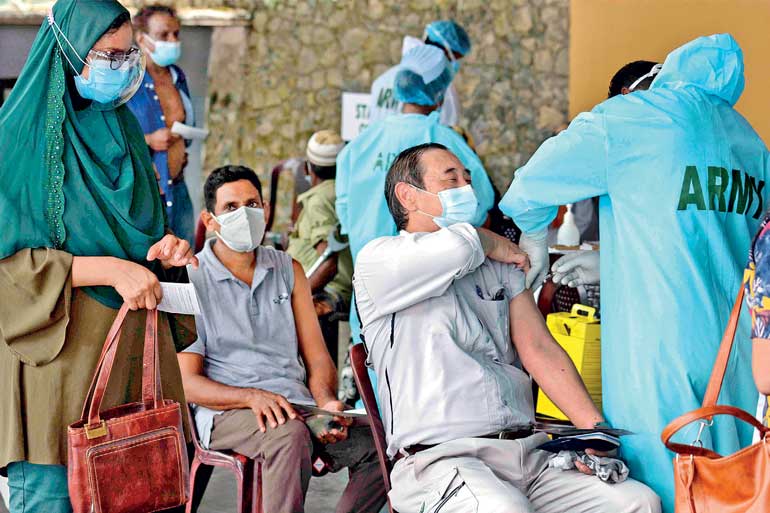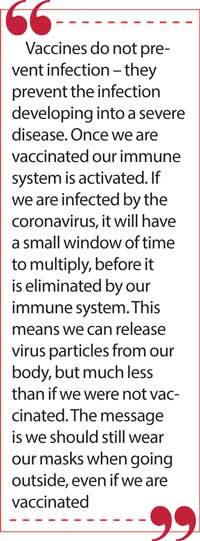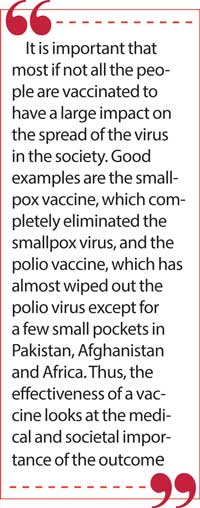Thursday Jan 01, 2026
Thursday Jan 01, 2026
Tuesday, 10 August 2021 02:58 - - {{hitsCtrl.values.hits}}

After vaccination our immune system is primed to combat the coronavirus, reducing the multiplication of the virus in our body. This will gradually slow down the spread of the virus as more and more people are vaccinated – Pic by Shehan Gunasekara
 The vaccines against COVID-19, available today are based on different strategies and come with different numbers to indicate their performance. Many of us wish to know if one vaccine is better than the other.
The vaccines against COVID-19, available today are based on different strategies and come with different numbers to indicate their performance. Many of us wish to know if one vaccine is better than the other.
Two concepts underlying the performance of the vaccines are efficacy and effectiveness. The Pfizer and BioNTech vaccine have an efficacy of 95%, the Moderna vaccine is 94.5% and the Russian-made Sputnik vaccine is over 90%. Does this mean some vaccines are better than the other? The short answer is no. All the approved vaccines are equally good. So, let us look at what these numbers mean.
These numbers refer to statistical calculations to interpret the results of vaccination trials conducted by the manufacturers of vaccines following a prescribed format. The method of calculation was developed over 100 years ago by two statisticians, who published their results in the Proceedings of the Royal Society of Medicine in 1915.
They, Major Greenwood (Major is his first name and not a military title) and Udny Yule, were tasked with interpreting the results of immunisation of British soldiers against typhoid and cholera, who were fighting in different regions of Europe and Asia favourable to the development of cholera epidemics. In a paper stretching over 82 pages, the authors developed the theoretical and mathematical background for calculating the Efficacy of vaccines.
This article seeks to explain to the lay reader what these numbers imply and to bring out the differences between efficacy and effectiveness of a vaccine.
Efficacy and effectiveness
At first sight these two terms appear to be synonyms. However, in the world of vaccines and medicine these two terms are not the same. Efficacy of a vaccine is how it performs under ideal and controlled conditions in a clinical trial (see below).
During clinical trials the outcome of vaccination is compared between a group of vaccinated people and another group given an inactive form of the vaccine (called a placebo). The effectiveness of a vaccine is how the vaccine performs in the real world – that is after the vaccine is approved by the regulatory agencies and you and I are vaccinated.
The efficacy of a vaccine is measured by the manufacturers under ideal conditions in a clinical trial where criteria are specified for selecting and excluding volunteers. These criteria are usually, age groups, gender, ethnicity, geographical location, socio-economic standing, etc. If the criteria are specific, then the effects of the vaccine or drug would not be applicable across the population. For example, if the COVID-19 vaccines are not tested on children below 18 years, then the approved vaccine cannot be used on children.
The effectiveness of a drug or vaccine is a measure of how well the drug or vaccine performs in real life, in a diverse population: fitness geeks and couch potatoes, housewives and nurses, farmers and office workers, etc. Effectiveness is of relevance to the medical community and health care authorities who are treating the patients. Thus, studies on effectiveness would look at to what extent the vaccine is beneficial to the patient to prevent infection.
One may ask, why not simply look at the effectiveness of the vaccine? This is because if the participants in an initial trial of the vaccine are not carefully controlled, then it is difficult to interpret the outcome of the trial. We have many characteristics, which can potentially interfere with the outcome of a trial testing a vaccine. The person volunteering for the trial could be young or old, pregnant or not, a marathon runner or an average person, smoker or non-smoker, etc. Thus, the volunteers selected for the trials are very similar within their groups with many criteria to exclude persons who could confuse the results (e.g., an unhealthy person with other diseases would be excluded).
Efficacy of a vaccine asks the question ‘Does the vaccine work under ideal conditions?’ On the other hand, a study on the effectiveness of the same vaccine asks the question ‘Does vaccination work in the real world?’
 Clinical trials
Clinical trials
Under normal circumstances, vaccines take many years of research and testing to be approved. The COVID-19 pandemic was unprecedented, and pharmaceutical companies embarked on a race against time to produce safe and effective vaccines. The genome of this corona virus, which was discovered by Chinese scientists in January 2020, was a major contribution to the development of the vaccines. At the moment there are 94 vaccines being tested on humans in clinical trials, 32 of which have reached the final stage of Phase 3 testing.
To obtain approval of a vaccine, the vaccine manufacturers go through a prescribed process to ensure that the vaccine is safe. All the countries have a national drug approval agency, who should approve the use of a drug or vaccine in that country. The Food and Drug Administration (FDA) in the United States is an important regulatory agency, which has stringent criteria to approve medicines and drugs. In Sri Lanka, it is the National Medicines Regulatory Authority. COVID-19 vaccines are also assessed and approved by the WHO.
Initially, the vaccine is tested on cells in the laboratory and then given to animals, usually mice or monkeys. After this, if the mice or monkeys are happy, human volunteers are recruited to conduct the clinical trials, which is done in three phases. In the first phase, the vaccine is tested on a small group of people to determine the safety, dosage and ability to stimulate our immune system. If this is confirmed, the vaccine then moves into the Phase 2 stage where the safety of the vaccine is tested on hundreds of people who are split into different groups.
Once these trials are successful, the vaccine moves to the final Phase 3 trials. Here thousands of people are recruited as volunteers. For the Pfizer BioNTech vaccine there were over 40,000 volunteers above the age of 16 years from different countries. This trial is more comprehensive with the volunteers belonging to different age groups, physical fitness, ethnicities, geographical locations, etc.
The volunteers are divided into two groups. One group gets the real vaccine while the other group gets a fake vaccine or placebo (the syringe has just water). The volunteers would not know if he/she is getting the vaccine or a placebo and neither do the nurses and doctors giving the vaccine. This is called a double-blind clinical trial. Thus, no one knows, except those conducting the trial, who was vaccinated with what.
After some time, the volunteers who fell sick with the coronavirus are PCR tested to confirm if they are COVID-19 positive. The scientists will be on the lookout for any side effects of the vaccine; if they find any cause for concerns the trial can be stopped temporarily to conduct investigations and remedy the problem. If the scientists are not satisfied, the trial will be abandoned.
Once the results are in, the calculations are done, and all the details are submitted to the regulating authorities. The regulators would ask the manufacturers more questions and once they are satisfied, approval is given to manufacture and market the vaccine. To accelerate the process, such as now during the COVID-19 crises, Phase 1 and 2 may be combined and run in parallel.
 Calculating the efficacy of a vaccine
Calculating the efficacy of a vaccine
The calculations involved are quite simple once the data is collected. Let us assume that 50,000 volunteers were recruited for the vaccination trial. Half were given the vaccine and the other half a placebo. Let us assume that of the 25,000 who received the vaccine, 10 persons were infected, and of the other 25,000 who received the placebo, 200 were infected. Although the numbers of people infected are small, those in the placebo group are 20 times larger (see table). The researchers are concerned with the relative risk between the groups. This is called the efficacy of the vaccine. The risk of infection is calculated as seen in the table.
What is the difference in the risk of infection between the vaccinated group and those who got the placebo? From the table this is, 0.80% - 0.04% = 0.76%.
Thus, the vaccine reduced the risk of infection by 0.76%, which looks quite small. This is what would happen if we are vaccinated. To understand this is in terms of the risk of infection, if none were vaccinated, we look at the ratio of the Reduction in Infection (0.76%) to the Risk of infection (0.80% - those who got the fake vaccine). This is the Vaccine Efficacy (VE).
VE % = Reduction in infection ÷ Risk of infection = 0.76 ÷ 0.80 = 95%.
If this is still confusing, let us see what it means in a population of 100,000 persons who are vaccinated with a vaccine of 95% Efficacy, and exposed to the virus. From the table above, the risk of infection for the vaccinated population is 0.04%, which translates to 40 persons (0.04% x 100,000). That is, we can expect that 40 persons would fall ill with an infection by the corona virus and the rest of the vaccinated people may not develop an infection at all or develop an asymptomatic infection (you are infected but do not show symptoms) or get a mild disease.
(This example of calculating vaccine efficacy is adapted from an article by Dashiell Young-Saver in the New York Times of 13 December 2020, where the above calculation is explained in detail for students.)
What does efficacy of a vaccine mean?
The efficacy of a vaccine refers to two aspects. The first is how many of us are protected by the vaccine if we are exposed to the virus; this is given by the percentage. The vaccine also refers to different disease conditions it is capable of preventing. This could be causing an infection, mild disease, severe disease, hospitalisation, or death. This information can be found if one looks carefully at the statements issued by the vaccine manufacturer and Regulatory agencies.
For example, the statement by Pfizer BioNTech states: Pfizer-BioNTech COVID-19 vaccine, BNT 162b2, was 91.3% effective against COVID-19 (symptomatic cases of COVID-19), measured seven days through up to six months after the second dose. The vaccine was 100% effective against severe disease as defined by the US Centers for Disease Control and Prevention (CDC), and 95.3% effective against severe disease as defined by the U.S. FDA.
The efficacy of a vaccine (VE) is the relative reduction of being infected, if we are vaccinated, compared to the placebo or unvaccinated group. If the vaccine is perfect, then the risk of being infected is totally eliminated, so that VE = 1 or it is 100%. On the other hand, if there is no difference in the number of people infected between the two groups, the vaccine has no efficacy, or it is zero. Even with a perfect vaccine, our capacity to acquire an infection is determined by our age, health, immunity status etc.
In short, efficacy is a statistical measurement based on clinical trials, of the vaccine’s ability to prevent infection. The volunteers taking part in the trials are not a perfect sample or representative of the real world (for example, children and sick people do not take part). Is there a lower limit for the efficacy of a vaccine to be accepted? Under the present circumstances, the FDA said it would consider granting emergency approval if the vaccines showed even 50% efficacy; the vaccines that have received approval now show an efficacy of over 90%.
Effectiveness of the vaccines
Effectiveness of the vaccine tells us how well the vaccine is performing among the population in the real world to prevent infection. The effectiveness of the vaccine depends on the impact it makes on the society. After vaccination our immune system is primed to combat the corona virus, reducing the multiplication of the virus in our body. This will gradually slow down the spread of the virus as more and more people are vaccinated.
In other words, it is important that most if not all the people are vaccinated to have a large impact on the spread of the virus in the society. Good examples are the smallpox vaccine, which completely eliminated the smallpox virus, and the polio vaccine, which has almost wiped out the polio virus except for a few small pockets in Pakistan, Afghanistan and Africa. Thus, the effectiveness of a vaccine looks at the medical and societal importance of the outcome.
Vaccines do not prevent infection – they prevent the infection developing into a severe disease. Once we are vaccinated our immune system is activated. If we are infected by the coronavirus, it will have a small window of time to multiply, before it is eliminated by our immune system. This means we can release virus particles from our body, but much less than if we were not vaccinated. The message is we should still wear our masks when going outside, even if we are vaccinated.

(The writer is Associate Research Professor, Plant and Environmental Science, National Institute of Fundamental Studies, Hanthane Road, Kandy. He can be reached via [email protected])
References
Zimmer, C. New York Times Nov. 20, 2020. Two companies say their vaccines are 95% effective. What does that mean?
Haelle,T. Association of Health Care Journalists. October 22, 2020. Know the nuances of vaccine efficacy when covering Covid-19 trials. https://healthjournalism.org/blog/2020/10/know-the-nuances-of-vaccine-efficacy-when-covering-covid-19-vaccine-trials/
Greenwood, M., & Yule, G. U. (1915). The Statistics of Anti-typhoid and Anti-cholera Inoculations, and the Interpretation of such Statistics in general. Proceedings of the Royal Society of Medicine, 8 (Sect Epidemiol State Med), 113–194.
Food and Drug Administration, US Department of Health and Human Services. https://www.fda.gov/media/139638/download